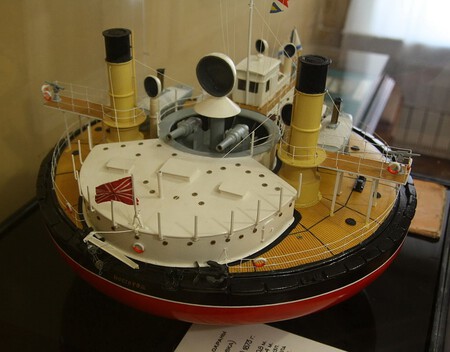If something works, why touch it? Of course, it is not the maxim from which the history of technology has made the most profit, nor the one that most encourages innovation; but there are times when she is the smartest. Tell them if not Andrei Alexandrovich Popov, architect of one of the most curious and ill-fated vessels of the Russian Navy, to which he even gave a name: the “popovkas”, combat ships with weapons, boats… and a circular shape. Exactly, just like gigantic water lilies.
In the second half of the 19th century, Andrei A. Popov, an officer in the Imperial Russian Navy, came to the unorthodox conclusion that what his country’s fleet really needed was wafer boats. It sounds crazy, but Popov was not the first to think of the advantages of such a model, nor was his reasoning, seen calmly and on paper, so extravagant.
After the end of the Crimean War and the Paris treaty, the Black Sea had been turned—at least in theory—into a vast military-free area, a prospect Russia was not entirely comfortable with. Without her warships and fortifications securing the area, she was exposed to the Ottoman Empire. As if that were not enough, the measure did not contribute to her aspirations to obtain direct access to the Mediterranean. A solution was needed. And as soon as possible.
In its favor Saint Petersburg had pretty clear ideas: I wanted warships that would adapt well to the setting, capable of defending the coasts of the strategic Kerch Strait and the mouth of the Dnieper River. And above all, intimidate any enemy that roamed the area.
Clear ideas… on paper
Analyzing the situation, Popov came to the conclusion that it was best to opt for light, well-armed structures capable of defending the coastline and… —the really curious thing— with a circular design, more similar to donuts than ships. He was not the only one convinced that in certain circumstances such a design was more interesting than the traditional stylized configuration of ships.
The advantages of ships with a wide beam had already been traced by the prestigious Scottish engineer John Elder and, far from Glasgow or Saint Petersburg, they also caught the interest of Edward Reed. Reasons were not lacking, as they remember in goes boats Y The Green Compass.
at least on paper.
By stretching its beam to its maximum, the boat reduced the draft and the surface that had to be armored. Not to mention that she theoretically gained the ability to carry large-caliber guns. She lost speed, true, but that was nothing that could not be alleviated with good engines.
Popov outlined, in short, a ship capable of handling in shallow waters and show off an armament that would scare the most painted of enemies. Perhaps its configuration was a bit bizarre, but in engineering applied to warfare, it didn’t matter much either.

The idea was solid enough to convince the Grand Duke Kontstin Nikolayevich, admiral of the Navy, so Popov was able to go from paper to shipyard. It was decided to manufacture four units and after several prototypes that the Tsar himself nicknamed “popovka” the ship began to be manufactured in April 1871 and was completed almost on New Year’s Eve of that same year.
Although Nikolayevich had initially opted for a spacious design, 46 meters in diameter, equipped with four guns and more than 6,000 tons of displacement, its invoice was so stratospheric that he had to settle for a somewhat smaller and more adjusted version of 29 m. The baptized as Novgorod it would end up slightly exceeding 30 m in beam with a draft of 4.1 m and almost 2,500 tons of displacement.
The wafer shape was not the only curious thing about Novgorod.
His own logistics seem like something out of a Kafka story. Once the ship was finished, the Navy decided to dismantle it and move it by pieces first aboard a train and later by barge from St. Petersburg, where it had been assembled, to Nikolaev, its final destination on the shores of the Black Sea. The Novgord was not launched until later, in mid-1873.

Picture showing the Novgorod arriving at Sevastopol.

Engraving showing the ship Vice Admiral Popov in 1878.

View of one of the “popovka” in which its propellers can be seen.
It was not the only “popovka” that would cross the waters. In 1972, the construction of another similar vessel, the kyiv, later known as the Nikolaev, had begun in Nikolaev itself. Vice Admiral Popov in a nod to the veteran officer who had raised the model. The ship was completed in 1876, in time for the outbreak of the War of the East – which lasted from 1877 to 1878 – during which the Novgorod focused mainly on the defense of the Odessa coastline.
The (not very epic) legend of the “popovka”
Were circular boats so good idea as Popov believed at the beginning of that same decade? No, although in fairness the result of it was not as bad as the fame that the “popovka” have earned, of which it is even said that they rotated with the force of each shot, leads one to believe.
Reality –precise va ships— is that the bases of the ship’s cannons had a fault that affected the cannon shots and the technicians had to correct them. The alleged spin without control is not, in any case, the only one but of the peculiar ships of officer Popov.
When sailing in calm areas its structure was stable, but things got complicated when sailing strong currents. Between the ups and downs, maneuvering the cannons was not easy.
He wasn’t particularly agile in turns either, maneuvering slowly, reaching very limited speedbarely 6.5 knots, and the management of its steam engines required transporting a considerable load of coal that —points the Green Compass— it deprived him of autonomy.
“They were not able to navigate the open sea and were slower than turtles. On the other hand, the force of the shots made the ship turn on itself. These ships could have played a minor role, just as a means of coastal defense, but not prominently either.” the ex-commander points out of the Black Sea Fleet, Igor Kasatonov, in statements collected by Russia Beyond. To make matters worse, they weren’t very well thought out to accommodate a crew either.
Despite their discreet record of service to the Novgorod Chronicle and Vice Admiral Popov they still had a few pages to write. Of course, without great episodes. Over the following years they continued to modernize, their weapons were reinforced and they were assigned to coastal defense, the scenario in which they defended themselves best. In 1903 they were given retirement and in 1911, after a frustrated sale, they ended up pointing their ¿prow? to the scrapyard, where its last chapter was written.
Or not.
The “popovka” they weren’t the only ones boats that explored the possibilities of expanding the beam to unprecedented levels. Popov’s theories would still be tested on another ship, the Livadia, which was launched in July 1880 with a slightly more streamlined design that kept it from looking like a huge saucer. Even today, well into the 21st century, she remains in service a circular boat.
Images | Wikipedia, Zandcee,
Красовский Н.П.















